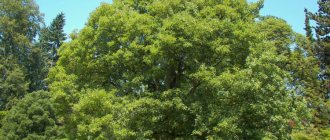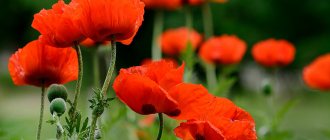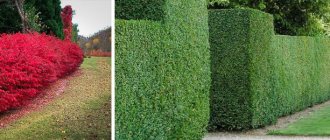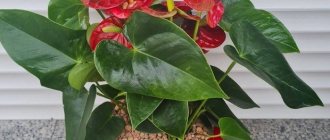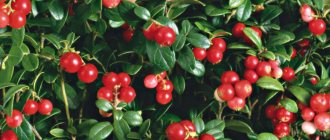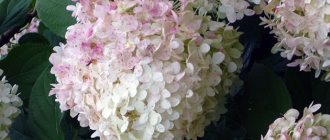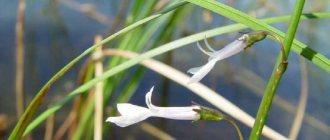When thinking about designing their own garden, many people dream of contemplating all season long something charming, beautiful enough to decorate the front area and at the same time, not requiring constant attention. Paniculate and tree-like hydrangeas meet all these requirements and are ideal for growing in areas near Moscow.
Dozens of different varieties allow you to play with heights and shades. Thanks to such diversity and conditions favorable for growth, this shrub is called universal. In this article we will look at just a few fundamentally different options for using hydrangea in garden landscape design and learn about all its advantages.
Hydrangea with perennials
For example, imagine a situation where buildings, a fence or other structures form a corner on a site that receives no more than 4 hours of sunlight during the day. Someone was already desperate to improve this place and equipped it for storing tools, a garden cart, and maybe even gave it over to weeds. Hydrangea will cope with this task without effort. The picture below shows a specific example of such a mixborder.
Surrounded by interesting landscape stones and shade-tolerant perennials, this shrub looks attractive, maintaining its beauty until frost. Please note: the composition is located right next to the house, but the plants are chosen so advantageously that they are not afraid of snow falling from the roof. In winter, perennials lack an above-ground part, and in hydrangeas, even if the branches break off, in the spring the buds below the break will wake up, developing shoots that will be crowned with inflorescences in July.
Where can't you plant?
- You should not plant the shrub in strong shade; the complete absence of sunlight will not allow the buds to fully form.
- If the hydrangea grows in the open sun, this will lead to premature flowering.
- If you plant hydrangea in a swampy area, this will lead to rotting of the roots. The plant will constantly get sick and die faster.
Hydrangea will become an elegant and spectacular decoration of any garden. It matches with many plants and is easy to care for. By planting a composition with this shrub on your site, you will create a festive mood for yourself every day.
Mixborder with hydrangea in the shade
Sometimes the shadow is formed by the crown of tall trees growing on your or a neighboring site. As a rule, this is not such an inconspicuous corner, which means it is simply necessary to improve it. We offer you an all-round view composition option that will look charming from any point. And the spotlight is again on two charming hydrangea bushes.
It is worth noting that there were also landscape stones here. Thanks to them, the composition has a natural style and does not seem “naked” in the spring, while the plants have not yet woken up. For this mixborder, not only classic shrub forms, but also standard forms of hydrangeas can be suitable.
If you really decide to improve a shady corner on your site, we recommend that you read the article, where there are many species and varieties of shrubs and perennials that will be comfortable in partial shade.
Decorative deciduous and coniferous frames
Another opportunity to beautifully highlight a hydrangea bush so that all attention is concentrated on it is to plant a plant next to it without flowers, but with large leaves. It’s easy to guess that we’ll be talking about hostas, heucheras or ferns. Like hydrangeas, ferns prefer shady places.
As for hostas and heucheras, there are so many species of these plants that you can easily choose what you need in terms of size, foliage color and other characteristics. Impeccable companion plants will give the flower garden the desired shape, while at the same time bringing to the fore the spectacular prima - hydrangea.
Coniferous plants can play exactly the same role in hydrangea. Devoid of flowers, like ferns, they create the perfect backdrop for the blooming beauty of hydrangea.
Parterre flower garden with hydrangea
Rows of low-growing hydrangeas can decorate a parterre flower garden. Perennials will highlight the attractiveness of these flowering shrubs and create a contrasting background for bright and large rose buds. Over the years, hydrangeas will grow and form an interesting border with lush greenery in the first half of summer and lush white inflorescences at the end of July, which will begin to turn pink closer to autumn.
Using these three options as an example, we found out that hydrangea can not only highlight the advantages, but also hide the shortcomings of your site. Knowing about these features of the shrub and taking into account the nuances of the variety, you can use it for almost any purpose.
If we talk about mixborders, then you should choose paniculate hydrangeas, because most tree-like hydrangeas have a certain feature due to which the integrity of the composition may suffer: their inflorescences are incredibly large and under their weight the shoots can bend almost to the ground, increasing the diameter of the bush and making its somewhat sloppy. But many find a solution to this situation too. You can build a retaining structure along the perimeter of the bush and plant plants nearby that will cover it from view. What is tree hydrangea best suited for?
Flowerbed for beginners
Caring for hydrangea in spring - how to properly replant hydrangea
To create a simple flower bed, it is advisable to use flowers that do not require special care and growing conditions, but you can be sure of their long-lasting attractive appearance and flowering time. As a basis for a simple flower bed, you can take a diagram: in the center there is a hydrangea, then bulbs (daffodils and tulips), astilbe, fern, chrysanthemum, violet, lily of the valley, marigolds, and carnations are planted in a circle.
Simple flower bed
Children's flowerbed
Creating a children's flowerbed is a great way to captivate a child, teach him to work, respect for nature, and responsibility. To make the activity fun, you can plant colorful flowering bushes.
At the same time, when decorating a flowerbed for a boy, flowers in blue colors are used (crocuses, violets, muscari, delphiniums, scillas, forget-me-nots, cornflowers, nigella, asters). The highlights of the composition can be blue or purple hydrangea, as well as blue spruce.
For girls, delicate flowers of red-pink color are selected (hyacinths, tulips, peonies, lilies, daisies, pansies, petunias). Viburnum or rhododendron can complement the flowerbed.
Shady flower bed with daylilies
If you need to decorate a corner where there is almost no sun, you can try the following flower bed option. In the center are hydrangeas of the Kyushu variety and daylilies (common red or Stela de Oro). Next - late-flowering narcissus, hosta zibolida, wood violet, ivy and columbine. This composition always looks fresh and original and requires virtually no maintenance.
Hydrangea with daylilies
Flowerbed along a fence or wall
A riot of hydrangea along the wall of a house or fence is a stunning and unique sight. This result is difficult to achieve, but it is impressive. When planting hydrangeas, you should immediately determine which plant will be the tallest. If it is a hydrangea, then a tree-like species is selected and planted in the background. At the front, the flower garden is complemented by small flowers and herbaceous plants.
If a conifer or other tree is chosen as the largest crop, it is placed at the back. Hydrangea should be selected paniculate and planted in the first row.
Hydrangea by the fence
Hydrangea is a beautiful and spectacular plant that is easy to care for and is in demand in landscape design. It goes well with many flowers, trees, and herbaceous areas, thanks to which you can create original and unique compositions. Hydrangea will be a worthy decoration for any garden or flower bed.
Tree hydrangea hedge
Quite often this species can be found both in a single planting and in a hedge, when the lack of elasticity of the shoots is used as an advantage.
If in the first case the bush seems to be holding up a charming border of thujas of the “Danika” variety, then in the second the shoots gracefully fall onto the surface of the water, being reflected in it and giving depth and scale to the landscape.
Features of using plants in landscape design
The designer’s task is to emphasize the features of the relief; when designing a garden, the decorative qualities of plants are taken into account. Grass usually serves as the background of the composition. Habit crops are selected according to the shape and density of the crown, growth rate and resistance to shearing are taken into account. Decorative deciduous trees are valued for the originality of their foliage shape and color. The combination of such crops with evergreen conifers always looks advantageous.
For many owners of country houses and cottages, the issue of designing a personal plot is an important and relevant topic.
Flowering plants will help create color accents; they are used for border decoration and single planting. Fruit-bearing crops decorate the autumn garden, climbing plants perfectly decorate the walls of the veranda and gazebo. Carpets visually smooth out the relief.
By combining plants in landscape design with various decorative qualities, it is possible to create harmonious compositions.
In this case, you need to take into account several factors: climate, conditions, soil quality, the main characteristics of a particular plant.
Decorating a recreation area with tree hydrangea
This shrub, even without the support of other plants, will decorate any part of your garden in a monochrome, sophisticated style. True, unlike paniculata, tree hydrangea bushes are not so tall, so the background can be a building wall or a fence, if they look attractive, or slender rows of thujas, as an option.
What do hydrangeas like, how to choose a suitable place for planting
Hydrangeas are very delicate flowers. They love peace, light partial shade and generous watering. The place for flowers is chosen according to strict criteria:
- The flowerbed should be located in an open space, so that the sun illuminates it in the morning and evening;
- An obstacle is required on the south side to provide shade at midday;
- A place is chosen on the leeward side near the house or artificial obstacles are created for the wind - strong gusts and constant drafts are destructive for hydrangea;
- The soil should be loose, fertile, with a lot of organic matter. If the soil on the site is clayey with an acidic or pronounced alkaline reaction, you should apply neutralizing substances, fertilizers and loosen the soil in advance;
- Frequent watering is required - 1-2 times a week, depending on the weather and age of the bushes. Young hydrangeas are watered more often, old hydrangeas less often. If you recently planted it, you need to water it every day. Water for irrigation - only warm, heated in the sun or in a kettle;
- Groundwater and puddles are harmful to hydrangeas - such water is always cold. The bushes need to be planted on a hill.
The ideal place is a small elevation slightly away from the southern wall of the house, so that there are no outbuildings or an outdoor washbasin nearby, on prepared soil.
You can plant and replant bushes only in the spring; this cannot be done in the fall. Regular watering should also not be ignored.
Hydrangea paniculata hedges
They are not rare and look simply gorgeous. Some varieties of this species are capable of reaching a height of three and sometimes four meters, creating stunningly beautiful hedges that cannot be ignored and appreciated by their majesty.
In both cases, the designers played with heights to their advantage. In the first photo we see how lush inflorescence caps barely rise above the terrace fence, creating an elegant snow-white border. And in the second photo, the shrubs are planted on a high retaining wall, which certainly adds scale to the landscape and allows you to plant far from the lowest shrubs in front of this wall, creating a multi-tiered effect.
Care Tips
Beautiful and neat areas always attract the attention of others, and are also a real decoration of the territory. Summer residents and gardeners have certain rules for care, which consist of the following actions:
- Trimming. It involves removing dead and damaged branches or trunks.
- Mulching. The distribution of organic material around plants in the form of a loose layer.
- Loosening. Flushing of soil in the area of the root system.
- Feeding. Fertilizing the soil with special substances that promote their full growth and development.
- Shelter. Protecting plants from frost using materials specially designed for this purpose.
- Tying. It is produced to give plants a beautiful shape and strengthen the branches.
- Watering. Creating the required level of moisture.

